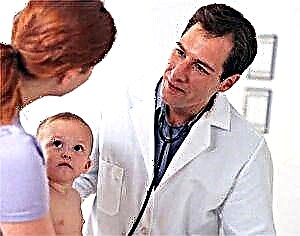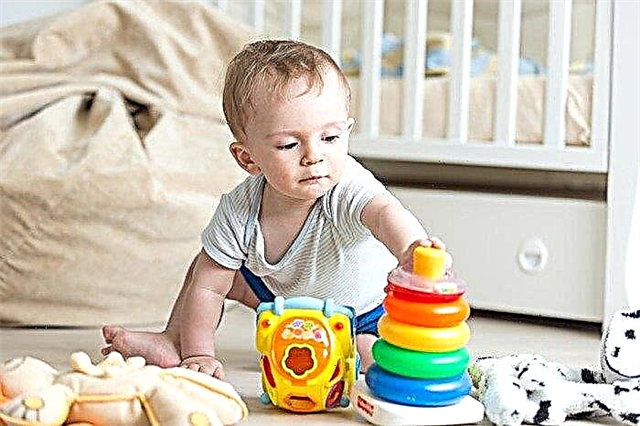
Rubella infection is one of the most common diseases in babies. According to statistics, every second child under three years of age is sure to be sick with rubella. The disease is very common. In order to recognize a childhood viral infection in time and prevent complications, parents should know the main manifestations of the disease.

What is it?
Rubella has a viral cause, it is caused by the smallest virus Rubella virus, which survives extremely poorly in the external environment. However, without special disinfecting treatment, the virus can remain in the air for a long time. Under the influence of external factors, it dies very quickly. Destructive for it are: ultraviolet radiation, quartzization, exposure to high temperatures and aggressive chemical liquids (formalin or compounds containing chlorine).

The virus survives well at very low ambient temperatures. For this reason, more and more rubella cases are reported every year during the cold season.
The virus is very volatile, quickly transmitted from a sick child to a healthy one. The child's body is very susceptible to this infection. According to statistics, the peak incidence of rubella occurs at the age of 2-10 years.

Causes
The virus, after passing through the developmental cycle in the child's body, causes many unpleasant clinical symptoms in young children. A sick child acts as a source of infection. It should be noted that not always babies may have acute manifestations of the disease. For a long time, approximately 15-20% of babies can only be virus carriers and infect other children. Their disease usually proceeds in an erased form.
If a baby is breastfed, it can easily get rubella from the mother. The viruses that cause the disease are small in size and perfectly penetrate into breast milk through the blood. If a mother gets sick with rubella, the baby also gets sick after a while.
In more rare cases, doctors note the congenital form of the disease. If a woman contracted rubella during pregnancy, she passes the virus across the placenta to her unborn baby.
In closer teams, the risk of getting sick is much higher. Scientists note that rubella occurs much more often in large cities than in rural areas. Epidemic outbreaks are usually recorded every 5-6 years. Doctors note that the incidence of rubella among pregnant women is increasing every year. This unfavorable and even dangerous situation is primarily associated with insufficient vaccination against infection.

Stages of the disease
During the course of the disease, there are several successive stages. After contact with a sick child, a large number of pathogens of rubella infection enter the body of a healthy baby. In more crowded groups (kindergartens, schools, sports clubs), the risk of infection increases several times.
You can get rubella in several ways:
- Airborne droplets. In this case, viruses from a sick child to a healthy one are transmitted during communication or violations of personal hygiene rules. The susceptibility to the disease in babies is very high. A small amount of time and microorganisms is enough for infection to occur.
- Vertical. In this case, the pregnant woman infects her unborn baby through the placenta. Rubella viruses perfectly penetrate the placental barrier and reach the baby's organs with blood flow. A baby after birth can remain infectious for several months.
- Contact. Infection occurs when sharing common household items: bed linen and towels, mugs and tableware, toys, toothbrushes. The contact method of rubella infection is most relevant for babies attending kindergarten. Insufficient disinfectant treatment of toys leads to massive outbreaks of the disease in preschool institutions.

On average, the incubation period of the disease is 2-3 weeks. This is the time from the moment the virus first enters the body until the development of clinical symptoms of the disease. As a rule, after 7-10 days from the moment the pathogen enters the body, the child becomes infectious.
First, the virus invades the superficial epithelial cells of the upper respiratory tract. There he begins to actively reproduce. After a while, it already penetrates the lymph nodes and spreads through the blood throughout the body. At this time, the second week of the incubation period usually ends. If diagnostics are carried out, then it is during this period that it will be possible to still detect a large number of viral particles in the mucus of the nasopharynx and pharynx.
At the end of the incubation period, the amount of the virus in the body already reaches a huge amount. With the blood flow, the pathogen spreads throughout the body, penetrating into almost all internal organs. At this time, babies show the first symptoms of rubella infection.

How to recognize: the first signs
It is often difficult to make a correct diagnosis during the incubation period. The child is practically not worried about anything. Skin manifestations are still absent. During the first three weeks from the moment of infection, the child may have a fever, and a slight general weakness appears. Children at this time become more capricious, their mood worsens. However, these signs are not specific and do not allow one to suspect the disease in the early stages.
The first characteristic symptoms appear by the third week of the disease. At this time, many groups of lymph nodes are greatly enlarged. The lymphatic groups in the back of the head are most affected. They become so large that they can even be clearly seen and felt. During the examination of the neck, the baby does not feel pain.
The lymphatic groups of nodes located in the armpit, groin and under the jaw are enlarged. On palpation, they are quite large and dense. In some cases, even some redness can be seen over the damaged skin. By the end of the third week, babies have a slight pain in the back of the head. It may intensify somewhat with sudden movements or turns of the head.
As a rule, a rash characteristic of rubella infection appears 2-3 days after the end of the incubation period. First, it appears on the scalp, neck, and also on the face. The rash consists of small red elements (2-4 mm). They can merge with each other, various patterns appear. The rash does not itch. It arises due to the fact that the virus, during its reproduction, releases toxic products into the blood. They damage the blood capillaries and cause them to rupture.

The rash begins to spread rapidly throughout the body after 3-4 hours. Red elements can be seen on all areas except the palms and soles. It is also one of the characteristic clinical signs of rubella infection. After 4 days, the elements of the rash gradually begin to turn white, decrease in diameter. After another 5-7 days, it completely disappears without leaving disfiguring scars or scars on the body.
For the longest time, rubella rashes can persist on the skin of the buttocks, as well as the inner forearms. During the period of the rash, the baby's well-being often improves.... Despite the creepy appearance, the baby already feels much better. At this time, body temperature normalizes, breathing improves, sleep and mood are restored.
During the period of skin manifestations, rubella infection is very similar to many other contagious skin diseases. The doctor must make a differential diagnosis. Other illnesses can also present with a rash. Any professional knows how to distinguish a red infection from allergies or other childhood infections that can cause red spots on the skin. Rubella rash has many distinctive features that make it possible to accurately diagnose correctly.


Forms of the disease
Rubella infection can take several forms.
With a typical or usual form of the disease, the child develops all the classic symptoms of the disease (with the obligatory appearance of a rash). In some cases, an atypical variant occurs. With this option, there are no manifestations on the skin.
The diagnosis of an atypical variant is noticeably complicated. This requires the use of special laboratory tests that will help verify the result and identify the exact causative agent of the infection.
Rubella is very often disguised as many other childhood diseases, manifested by the appearance of a rash. With rubella, for example, cutaneous manifestations also appear. However, with measles, the child's well-being suffers to a greater extent. The babies have a very high temperature, no appetite. The elements of the rash do not merge with each other. In order not to make a false diagnosis, the doctor must necessarily observe the baby from the very first hours of the disease.

Diagnostics
For differential diagnosis, doctors may prescribe additional laboratory tests. The most common test is the serological determination of specific anti-rubella antibodies. Blood is taken from a vein, as a rule, 5-10 days after the onset of the disease.
Detection of class M Ig and an increase in their number several times indicate the presence of an acute disease. The appearance of class G immunoglobulins in the blood indicates a past infection or a course of vaccination.

Treatment
In its development, rubella in young children is much easier than in adults. Only babies with reduced immunity or with chronic diseases can experience life-threatening complications.
However, the occurrence of adverse effects after rubella infection is quite rare.
Not everyone knows how difficult it is to cure rubella at home. If the disease proceeds in a typical and rather mild form, then the treatment is carried out at home. The need for hospitalization in an infectious children's hospital occurs only in difficult cases when the disease develops in a severe form. The decision on treatment in a hospital is made by the attending pediatrician. All babies with severe manifestations of the disease or having unfavorable complications are admitted to the hospital.

No antiviral drugs or antibiotics are prescribed to treat rubella infection... All therapy is reduced to adherence to non-specific methods of therapy. These include:
- Compliance with bed rest. For the entire period of acute manifestations, it is better for the baby to stay in bed. With the onset of a rash, the child can be allowed to get out of bed (but not earlier than a week after the first skin rash appears).
- Obligatory cleaning and disinfecting treatment of all objects and toys that are in the baby's room. Rubella viruses are killed very easily by exposure to such chemical agents. If there is a germicidal or quartz lamp at home, it can also be used to disinfect the room.
- Drink enough. To relieve intoxication symptoms, the baby must be given more liquid. It can be any drink up to 40 degrees. Hotter liquids can damage the oral mucosa and even cause ulcers. Choose compotes from dried fruits and berries, as well as various fruit drinks.
- Therapeutic diet. During a viral infection, the baby's need for many vitamins and minerals increases. There is a need for additional energy, which may be required to successfully fight the disease.
- Symptomatic treatment to address the underlying symptoms. For a cold, various nasal drops are used. To improve the general condition, doctors prescribe antihistamines. They will reduce drowsiness and even slightly reduce skin manifestations. When the temperature rises to 38-39 degrees, you can use antipyretic drugs. All drugs to relieve the main symptoms of infection should be prescribed by the attending physician, after a complete examination of the child.
- Get enough sleep. To recover quickly during infection, the baby must sleep at least 10 hours a day. During such a rest, the body's defenses are restored, additional energy appears to fight infection.


Diet
To quickly recover from rubella and recuperate, you need special nutritional therapy. The diet for a viral infection must necessarily include all the necessary substances (in sufficient quantities). Therapeutic food, which is prescribed to children in the acute period of the disease, includes:
- Divide meals into equal intervals. Toddlers should eat every three to four hours. Babies are applied to the breast every 2-2.5 hours. All servings should be approximately the same size.
- Gentle processing of products. In the acute period, it is strictly forbidden to fry foods or bake them with a coarse crust. All solid food particles can damage the inflamed oral mucosa and increase soreness.
- Semi-liquid consistency. The more food is chopped, the better for the baby. More liquid food is quickly absorbed and saturates the child's body with energy, without feeling of heaviness.
- All meals should be at a comfortable temperature. Foods that are too hot or cold irritate the oropharynx and increase inflammation. Before serving, soups and hot dishes are best cooled to a temperature of 35-40 degrees. To drink food, you can prepare a warm compote or morsik.
- Mandatory inclusion of protein products. For excellent immune function, a child needs to eat high-quality protein. Try to include foods containing different amino acids in every meal. Veal, lean poultry, or fresh fish are perfect for this. You can complement the dish with a side dish of well-boiled cereals. For babies in the first year of life, mashed vegetable purees are perfect.
- The inclusion in the diet of foods rich in vitamins and minerals. To strengthen the immune system, be sure to add fruits and berries to the child's diet. In the acute period, it is better to give preference to fruit purees or smoothies. They are easily absorbed and charge the body with all the necessary trace elements and vitamins.


Possible complications
Rubella is relatively mild and does not cause dangerous adverse effects in most children. Even in boys, the risk of developing serious post-infectious complications is much lower (compared to mumps).
Rubella causes the most unfavorable complications in pregnant women. If the expectant mother did not deliver the vaccinations on time, then her baby may still have developmental anomalies in utero... In the early stages of pregnancy, there is even a threat of miscarriage or fetal death.

The rubella virus has a particularly toxic effect in babies on the organs of the nervous system and the brain. A child may develop anencephaly, hydrocephalus, and visual disturbances. In some cases, the hearing organs are underdeveloped.
Quite common consequences can be congenital heart defects and dysfunction of the heart valves. In utero, babies develop heart valve defects, dislocation of large blood vessels.
The rubella virus is very dangerous for the unborn baby. It literally inhibits the development of vital organs and systems in the fetus. In many cases, pregnant women cannot even report, miscarriages occur. The virus also has a toxic effect on the formation of the immune system in the fetus. The underdevelopment of the cells of the future immune defense leads to the birth of children with congenital immunodeficiencies.
From the very first days of life, such children are very susceptible to any (even the most harmless) infections and require mandatory medical supervision.
The most relatively successful period of pregnancy is the third trimester.... If a pregnant woman becomes infected with the rubella virus at this time, then such pronounced negative consequences as in the first six months of pregnancy should not be expected. The laying of vital organs in the fetus by this time, as a rule, is already completed. If infected at this time, the unborn baby may develop congenital immunodeficiency or chronic diseases of the nervous system. In rare cases, hearing impairment occurs.
Prevention
The most adequate and reliable preventive measure is vaccination. All children (from one year old) must be vaccinated against rubella without fail. The first vaccination is given in a year and a half. When the child reaches the age of five to seven years, revaccination is performed.
After the vaccination, babies are reliably protected from the unfavorable course of rubella infection. The course of the disease in vaccinated and unvaccinated children is significantly different. Babies who have all vaccinations can also become infected. However, they do not have complications unfavorable to life.
You cannot get infected from a vaccinated person.
After the second vaccination (revaccination), children develop a very strong and strong immunity to the rubella virus.
Doctors recommend that all expectant mothers who are planning a pregnancy must be vaccinated against rubella. There must be at least three months between vaccination and conception. This time is needed to develop a sufficient level of protective antibodies.

Babies receive comprehensive vaccination against measles and mumps (along with rubella vaccinations). In all countries of the world, the staging of vaccinations against these infections is mandatory and included in national vaccination schedules. It is advisable to vaccinate before the child goes to kindergarten.
Rubella infection is a very frequent guest. The infection usually proceeds quite favorably, but the course of the disease must be carefully monitored. Timely diagnosis ensures correct observation of the baby during the entire illness.
For more details, see below in the program of Dr. Komarovsky about children's rash.
The program "Living Healthy" tells a lot of nuances about rubella.



